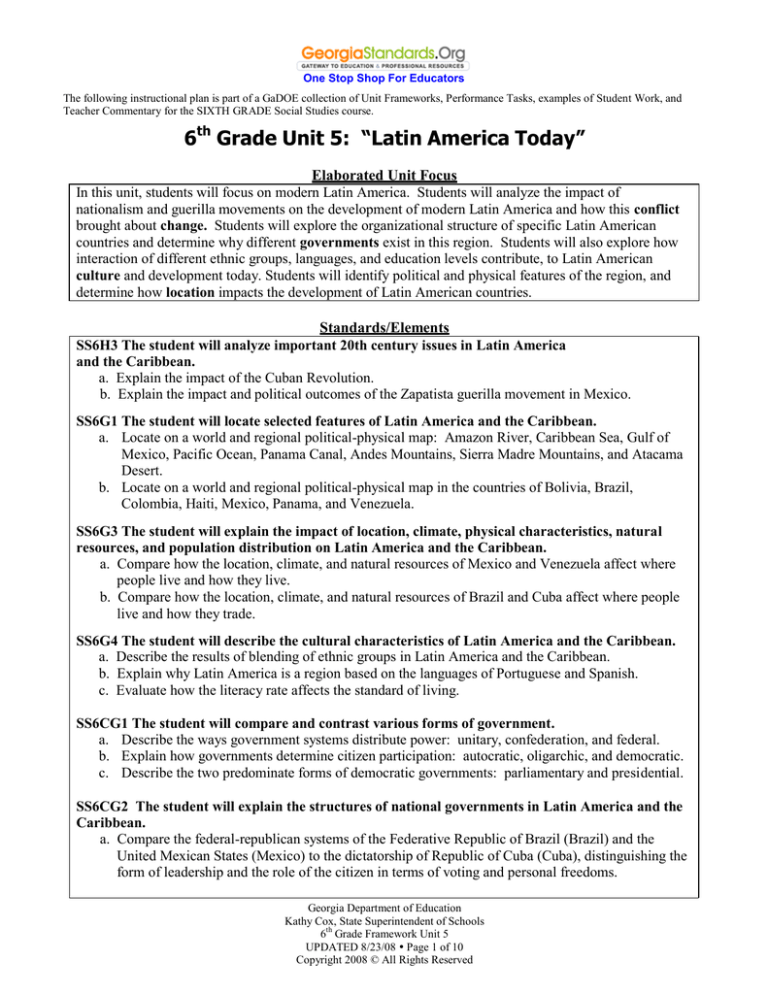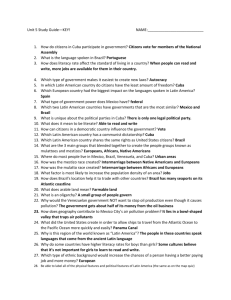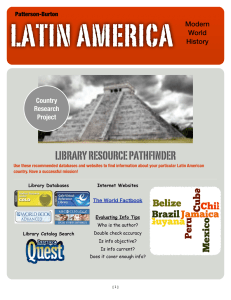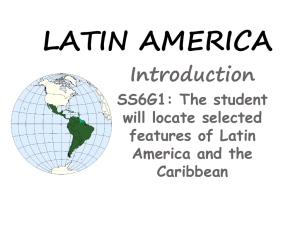
One Stop Shop For Educators
The following instructional plan is part of a GaDOE collection of Unit Frameworks, Performance Tasks, examples of Student Work, and
Teacher Commentary for the SIXTH GRADE Social Studies course.
6th Grade Unit 5: “Latin America Today”
Elaborated Unit Focus
In this unit, students will focus on modern Latin America. Students will analyze the impact of
nationalism and guerilla movements on the development of modern Latin America and how this conflict
brought about change. Students will explore the organizational structure of specific Latin American
countries and determine why different governments exist in this region. Students will also explore how
interaction of different ethnic groups, languages, and education levels contribute, to Latin American
culture and development today. Students will identify political and physical features of the region, and
determine how location impacts the development of Latin American countries.
Standards/Elements
SS6H3 The student will analyze important 20th century issues in Latin America
and the Caribbean.
a. Explain the impact of the Cuban Revolution.
b. Explain the impact and political outcomes of the Zapatista guerilla movement in Mexico.
SS6G1 The student will locate selected features of Latin America and the Caribbean.
a. Locate on a world and regional political-physical map: Amazon River, Caribbean Sea, Gulf of
Mexico, Pacific Ocean, Panama Canal, Andes Mountains, Sierra Madre Mountains, and Atacama
Desert.
b. Locate on a world and regional political-physical map in the countries of Bolivia, Brazil,
Colombia, Haiti, Mexico, Panama, and Venezuela.
SS6G3 The student will explain the impact of location, climate, physical characteristics, natural
resources, and population distribution on Latin America and the Caribbean.
a. Compare how the location, climate, and natural resources of Mexico and Venezuela affect where
people live and how they live.
b. Compare how the location, climate, and natural resources of Brazil and Cuba affect where people
live and how they trade.
SS6G4 The student will describe the cultural characteristics of Latin America and the Caribbean.
a. Describe the results of blending of ethnic groups in Latin America and the Caribbean.
b. Explain why Latin America is a region based on the languages of Portuguese and Spanish.
c. Evaluate how the literacy rate affects the standard of living.
SS6CG1 The student will compare and contrast various forms of government.
a. Describe the ways government systems distribute power: unitary, confederation, and federal.
b. Explain how governments determine citizen participation: autocratic, oligarchic, and democratic.
c. Describe the two predominate forms of democratic governments: parliamentary and presidential.
SS6CG2 The student will explain the structures of national governments in Latin America and the
Caribbean.
a. Compare the federal-republican systems of the Federative Republic of Brazil (Brazil) and the
United Mexican States (Mexico) to the dictatorship of Republic of Cuba (Cuba), distinguishing the
form of leadership and the role of the citizen in terms of voting and personal freedoms.
Georgia Department of Education
Kathy Cox, State Superintendent of Schools
6th Grade Framework Unit 5
UPDATED 8/23/08 Page 1 of 10
Copyright 2008 © All Rights Reserved
One Stop Shop For Educators
7Enduring Understandings/Essential Questions
CONFLICT and CHANGE: The student will understand that when there is conflict between
or within societies, change is the result.
What lasting impact did the Cuban Revolution have on Cuba and the region?
How do guerilla movements affect the politics in countries in which they exist?
How did the Zapatista guerilla movement affect Mexico?
How does the development of economic resources affect the political systems in Latin
America?
CULTURE: The student will understand that the culture of a society is the product of the
religion, beliefs, customs, traditions, and government of that society.
How has the blending of ethnic groups impacted the people and the culture in Latin America?
Why are the Spanish and Portuguese languages and religions significant in the cultural
development of Latin America & the Caribbean?
What is the relationship between the literacy rate of people in Latin America and the
Caribbean and their standard of living?
LOCATION: The student will understand that location affects a society’s economy, culture,
and development
What are the major physical features of Latin America and the Caribbean, and where are they
located on a map?
What are the major countries of Latin America and the Caribbean, and where are they located on
a map?
How do the factors of climate, access to water, and natural resources affect where Latin America
and the Caribbean choose to live and work?
Why is this region known as Latin America?
GOVERNANCE: The student will understand that as a society increases in complexity and
interacts with other societies, the complexity of the government also increases.
How is power distributed in different forms of government (unitary, confederation, and federal)?
How do citizens participate in different forms of government (autocratic, oligarchic,
democratic)?
What are the important democratic features of parliamentary and presidential forms of
government?
How do the federal governments of Brazil, Mexico, and Cuba differ?
What forms of leadership do the governments in Brazil, Mexico, and Cuba have, and how are the
leaders of these countries chosen?
What level of voting rights and personal freedoms do citizens have in Brazil, Mexico, and Cuba?
*NOTE: Evidence for student mastery of standards should include a balance of selected response, essay,
performance assessment or communication-based assessment yielding clear evidence for mastery of state
standards. (Rick Stiggins, 2004)
Georgia Department of Education
Kathy Cox, State Superintendent of Schools
6th Grade Framework Unit 5
UPDATED 8/23/08 Page 2 of 10
Copyright 2008 © All Rights Reserved
One Stop Shop For Educators
*NOTE: The balanced assessment plan included in this unit is presented as a series of suggested
activities. It is not expected that the teacher complete all assessments for a successful unit.
Balanced Assessment Plan
Description of Assessment
Standard/
Element
Students will be given an outline map of Latin America.
SS6G1 a,b
Students will draw the physical features and identify countries SS6G3a,b
as listed in the standards and elements. Students will design
a key to accompany their map to create thematic maps of Latin
America.
To be included in the key (symbols and colors)
The capital cities of Mexico, Brazil, Cuba and Bolivia
Venezuela
The climatic regions found in Mexico, Brazil, Cuba
and Venezuela
The resources found in Mexico, Brazil, Cuba and
Venezuela
After completing the map, students will choose either Mexico
and Venezuela or Brazil and Cuba to analyze (location,
climate, natural resources, and population density). Students
will write a 3 paragraph essay for each country. (Modification:
students may write a list of their analysis instead of a
paragraph.)
Paragraph 1- Describe the location of the country, climate, and
natural resources.
Paragraph 2- Describe where most of the people live in the
chosen country and why you think they live in that location
Paragraph 3- Describe the location of agricultural and
industrial regions of the country and describe the impact these
regions have on trade.
Conclusion: Students will either write a paragraph comparing
and contrasting their two countries or draw a Venn Diagram as
a graphic organizer to compare and contrast the two countries.
Students may share their conclusions with others that have the
same countries.
Georgia Department of Education
Kathy Cox, State Superintendent of Schools
6th Grade Framework Unit 5
UPDATED 8/23/08 Page 3 of 10
Copyright 2008 © All Rights Reserved
Type of
Assessment
*Constructed
Response
* SelfAssessment
One Stop Shop For Educators
Geography Review
Conduct a daily review of the physical features and location of
countries. This could be done informally or formally as a
game, exit slip, or selected response/constructed response.
Using a blank projected map, students will identify physical
features and countries.
Are All Federal Governments the Same?
Students with the teacher’s assistance will complete a chart
comparing and contrasting the federal governments of Mexico,
Cuba, and Brazil (Appendix A)
After completing the chart, students will create a poster,
brochure, PowerPoint or some other visual product introducing
the three governments. To be included:
Type of government
Form of Leader (name of current leader, picture, when
they became the leader and when they will leave
office)
Role of the citizen (Did the citizens vote? How was
the leader chosen? Are there multiple political groups
representing many ideas of the citizens?)
Notes to teacher:
To help students understand how citizens are represented and how
their voices are heard by governments, the teacher should preview
segments of the CIA Factbook.
To understand how the leader is chosen the teacher may use the
segments that describe the head of government and chief of state for
a country because it also tells how those leaders are chosen.
The portion of the CIA Factbook about how legislatures are chosen
can help students understand the role of the citizen. Are they elected
by the people or chosen by the leader? The information in the CIA
Factbook for political parties may
also be used to explain how different opinions of citizens are voiced
through political parties. Students should note how many different
political parties are listed in a country. Does this express freedom
of political expression? Does this show dissatisfaction with
government or unity?
Georgia Department of Education
Kathy Cox, State Superintendent of Schools
6th Grade Framework Unit 5
UPDATED 8/23/08 Page 4 of 10
Copyright 2008 © All Rights Reserved
SS6G1a,b
*Selected
Response
*Constructed
Response
SS6CG2a
*Constructed
Response
*Observation
*Dialogue and
Discussion
One Stop Shop For Educators
SS6H3a,b
The Power of the People?
The teacher will lead the class in a brainstorming activity
identifying ways people show displeasure or disagreement with
government. The students could then group their ideas into
either peaceful or non-peaceful movements. At this time the
teacher should introduce the terms guerilla movement and
revolution, defining each for the students to clearly understand.
It is important the teacher explains that the term “guerilla”
comes from “guer” which is the Spanish term for war. The
teacher will then explain to the students that Latin America has
experienced guerilla movements and revolutions as ways of
expressing displeasure or disagreement with their governments
and the treatment of people, specifically identifying the
Zapatistas of Mexico and the Cuban Revolution. The teacher
should then follow with a discussion of each of these events
and how each impacted either the governments or the lives of
the people in Mexico and Cuba.
In small groups, have the students summarize why they think
the people of these two countries showed their disagreements
in these ways and what the long term effects of these
movements have been. The students will write their summaries
on large chart paper, poster paper, butcher paper, etc. and then
display them around the classroom as a means of sharing (in
the form of a gallery walk). Individually students should take
some notes from these charts.
Who’s Who in Latin America?
1) Preview the DVD segment 1 “Overview of Latin America”
from the SCIS. (Southern Center for International Studies)
2) View the slide show on Latin American Ethnic Diversity-students should take notes particularly on the terms criollo,
mestizo, and mulatto
3) Facilitate the Lesson 1, Activity 3 in Latin America in
Transition from the SCIC, pp. 19-24.
Students should complete an end of unit assessment which
may include matching, multiple choice, fill-in the blank, short
answer, and essay.
Georgia Department of Education
Kathy Cox, State Superintendent of Schools
6th Grade Framework Unit 5
UPDATED 8/23/08 Page 5 of 10
Copyright 2008 © All Rights Reserved
*Constructed
Response
*Observation
*Dialogue and
discussion
SS6G4a,b,c *Constructed
Response
SSH3a,b,ce
SS6G1
SS6G3b
SS6G4c,e
SS6CG1a
SS6E1
SS6E2b
*Selected
Response
*Constructed
Response
One Stop Shop For Educators
Sample Performance Task
CONFLICT & CHANGE: The student will understand that when there is conflict between or
within societies, change is the result.
You will take on the role of either a leader of the Cuban Revolution or the Zapatista.
You (in the role chosen) must defend your position to a UN Committee studying change in Latin
America during the 20th century. You must describe your actions and explain the effects your actions
had on 20th century Latin America. You can present your position in either a PowerPoint presentation
or oral presentation using posters or charts.
You must address the following questions in your presentation:
Who are you and where do you live in Latin America?
What issues concern your country or region? Why are these issues significant?
What will be the long-term consequences if these issues are not resolved?
What actions have you taken?
Defend your actions. Why do you take the actions you take?
What beliefs can be contributed to your actions?
Why do you have the beliefs you have?
What effects have your actions had on your country?
Why do you feel people may misunderstand your actions?
How have your actions changed Latin America and/or your country?
Have your actions led to other conflicts?
What changes do you wish to see in your country?
Have you experienced conflicts which have led you to make changes in your life and/or country?
Map and Globe Skills:
Information Processing Skills:1,3,4,6,11,14,15,16
4,6,811,12
Georgia Department of Education
Kathy Cox, State Superintendent of Schools
6th Grade Framework Unit 5
UPDATED 8/23/08 Page 6 of 10
Copyright 2008 © All Rights Reserved
One Stop Shop For Educators
*Note concerning rubrics: Each performance task is accompanied by two rubrics: a content rubric and a product
rubric. The content rubric is designed to measure how well a student can use the standards to demonstrate the
enduring understanding(s). The second rubric focuses on the product of the performance task. This is where
students are scored on items involving grammar, punctuation, spelling, creativity, presentation, etc. It is intended
that the CONTENT rubric is weighed more heavily when assigning a grade to the students.
Content Rubric
Scale
Criteria
1
Below Standard
2 Needs Work
3
Meets Standard
4
Exceeds Standard
Identifies reasons
(beliefs) which led
to person’s/group’s
actions and
describes the effect.
Reason identified is not
realistic or accurate. An
effect is given, but it is
not accurate.
One reason is
correctly identified
and the description
of effect is correct.
Correctly identifies
two reasons the action
was taken and
correctly describes the
effect of the action.
Correctly identifies
two reasons the action
was taken and
correctly describes the
effect of the action.
The student describes
long-term effects seen
today.
Defends actions
taken by the
person/group
Action is stated but not
defended.
Action is stated but
the defense is
inaccurate or not
realistic.
Action is stated and
defended accurately
and realistically.
Action is stated,
defended realistically,
and the student
compares this action
to present day actions
occurring in the world.
Analyzes 20th
century Latin
American issues
Identifies an issue
relevant to Latin
America, but the issue is
not related to the
position or role chosen.
Accurately identifies
one issue concerning
the role or position
but does not provide
the significance.
Accurately identifies
two issues concerning
the role or position
and explains why the
issues are significant.
Accurately identifies
two or more issues
and explains why
these issues are
significant. Also,
explains the
consequences if the
issues are not
resolved.
Analyzes conflict
which led to a
change in Latin
America
Explains a conflict but
does not explain how
the conflict led to
change in Latin
America
Explains a conflict
and explains the
change which
resulted.
Explains a conflict
and explains the
change that resulted
as a long-term or
short-term change.
Explains a conflict,
explains the change
as a long-term or
short-term change and
explains whether the
change will continue
to last or is there a
possibility of conflict
again?
Georgia Department of Education
Kathy Cox, State Superintendent of Schools
6th Grade Framework Unit 5
UPDATED 8/23/08 Page 7 of 10
Copyright 2008 © All Rights Reserved
One Stop Shop For Educators
Resources for Unit
Zapatistas in Mexico
BBC
Global Exchange
South America, Central America, Caribbean Maps - (WorldAtlas.com)
This site provides interactive maps. You can click on a continent and then choose
a country. When you click on the country a map of that country will appear along
with a brief description and links to famous natives, fast facts, flag and symbols,
islands and regions, landforms, land statistics, latitude and longitude, maps, time,
timeline of history, travel information and weather.
South America map and facts page.
Central America map and facts page
Caribbean map and facts page
Bolivia
World Atlas
CIA World Factbook
Brazil
World Atlas
CIA World Factbook
Colombia
World Atlas
CIA World Factbook
Cuba
World Atlas
CIA World Factbook
Mexico
World Atlas
CIA World Factbook
Georgia Department of Education
Kathy Cox, State Superintendent of Schools
6th Grade Framework Unit 5
UPDATED 8/23/08 Page 8 of 10
Copyright 2008 © All Rights Reserved
One Stop Shop For Educators
Appendix A
Are all federal governments the same?
Use the CIA Factbook to find this information: https://www.cia.gov/library/publications/the-worldfactbook/geos/br.html
Country
Form of Leadership?
How is the leader
chosen?
Federative
Republic of
Brazil
United Mexican
States
Republic of
Cuba
Georgia Department of Education
Kathy Cox, State Superintendent of Schools
6th Grade Framework Unit 5
UPDATED 8/23/08 Page 9 of 10
Copyright 2008 © All Rights Reserved
How are the people
represented?
One Stop Shop For Educators
Appendix B
Guided Notes for “Power to the People?”
Cuban Revolution
Zapatistas
Year(s)
Location in
Latin America
Causes and
Issues
Impact on
Latin America
Answer the following questions using the completed chart:
1. Which of the people/groups do you think had the greatest effect on Latin America?
2. Why do you feel this way? Give examples to support your decision.
Georgia Department of Education
Kathy Cox, State Superintendent of Schools
6th Grade Framework Unit 5
UPDATED 8/23/08 Page 10 of 10
Copyright 2008 © All Rights Reserved




